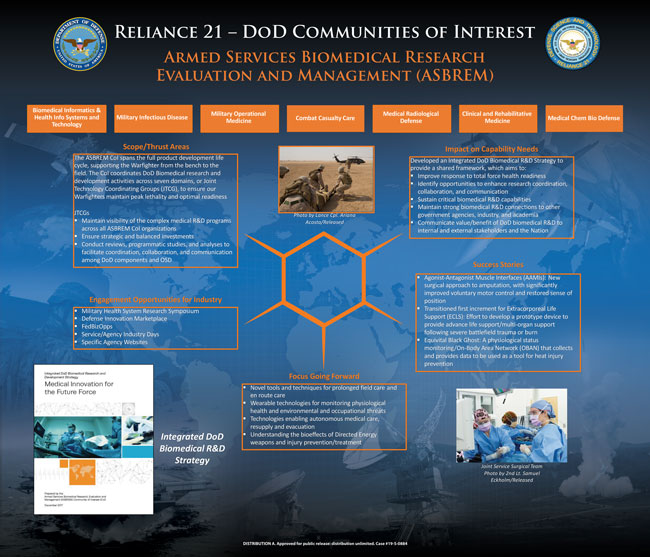Biomedical (ASBREM)
Communities of Interest
The purpose of the Armed Services Biomedical Research Evaluation and Management (ASBREM) CoIs is to: 1) Sustain and improve the program's responsiveness to medical readiness and warfighting needs; 2) Eliminate unwarranted duplication of effort within the program; 3) Promote program efficiency, stability and productivity by optimizing infrastructure, capabilities, coordination and information exchange among the Services and Defense Agencies; and 4) Provide a forum and mechanism to address program and management issues and organizational roles among the Services and Defense Agencies.
- Biomedical Informatics / Health Information Systems & Technology (BI/HIST): Research is focused on coordinating emerging military medical simulation and health information technologies/informatics research across all stakeholder communities and transferring research solutions and knowledge to meet DoD goals. Major categories of medical simulation and training research include: Combat Casualty Training, Medical Readiness Training, Health Focused Education, and Tools for Medical Education. Health informatics categories of research include: Theater/Operation Medicine, Health Services and Population Health, Health Operations Resourcing and Enterprise Infrastructure Management.
- Military Infectious Diseases (MID): The Research Program plans, coordinates and oversees a S&T infectious diseases research and development program leading to fielding of effective, improved means of protection and treatment to maintain maximal global operational capability with minimal morbidity and mortality. The program employs a requirements-driven process to protect the warfighter against naturally occurring, known, predictable, endemic diseases threats.
- Military Operational Medicine (MOM): Research is focused on developing effective medical countermeasures against operational stressors and preventing physical and psychological injuries during training and operations in order to maximize health, performance and fitness of Service Members. Major categories of research include Psychological Health and Resilience, Injury Prevention and Reduction, Environmental Health and Protection, and Physiological Health and Performance.
- Combat Casualty Care (CCC): The CCC Program seeks to optimize survival and recovery in service members injured in combat by planning, programing, budgeting and overseeing the execution of the full range of CCC Research across the spectrum of care from POI through en-route, and facilities. Areas of focus include those focused on medical issues such as Traumatic Brain Injury (TBI) and Hemorrhage Control, Resuscitation and Blood Products, as well as portfolios addressing care delivered in specific field medical environments such as Enroute Care and Forward Surgical and Critical Care. Medical photonics is a significant enabler, crosscutting the other portfolios.
- Medical Radiological Defense (MRD): The Radiation Health Effects Research Program JTCG-7 mission is to provide leadership and coordination with DoD, U.S. Government, and civilian research and development working in relevant areas and report these efforts. JTCG-7 contributes to JPC-7 efforts for planning and research oversight, development, test, and evaluation (RDT&E) activities of discovery and development of materiel and knowledge that reduce medical capability gaps relevant to radiation health effects, enhance military readiness in a radiation environment, and to enhance medical capabilities against radiation exposure. The principal focus today is research and development of medical countermeasures to prevent or treat the effects of Acute Radiation Syndrome (ARS). Comment: Radioactive materials are widely distributed in governments and civilian organizations worldwide for industry and medicine; are used in large quantities in power generation; are in nuclear weapons in numerous countries; and can be used potentially in improvised nuclear devices (IND). Radiation and nuclear risks represent a threat to U.S. forces, to U.S. facilities, and harm to American and international individuals and governments.
- Clinical and Rehabilitative Medicine (CRM): The Research Program focuses on developing knowledge and materiel products to reconstruct, rehabilitate, and provide definitive care for injured Service members (SM). The ultimate goal is to return the SM to duty and restore their quality of life. Primary research focus areas include Neuro-musculoskeletal Injury (prosthetics, assistive devices and rehabilitation and reintegration strategies), Pain (battlefield, acute and chronic), Regenerative Medicine, and Sensory Systems (Vision, Hearing and Balance).
- Medical Chem-Bio Defense (MCBD): The Chemical and Biological Defense Program plans, coordinates, and oversees research, development, testing, and evaluation of vaccines, therapeutics, and diagnostics against chemical and biological threats of security concern and novel and emerging infectious disease threats. The program employs a requirements-driven process to protect the warfighter against these threats to maintain maximal global operational capability with minimal morbidity and mortality.
Additional Materials
- Synthetic Biology Technical Assessment (PDF)
- Integrated DoD Biomedical Research and Development Strategy: Medical Innovation for the Future Force (PDF)
